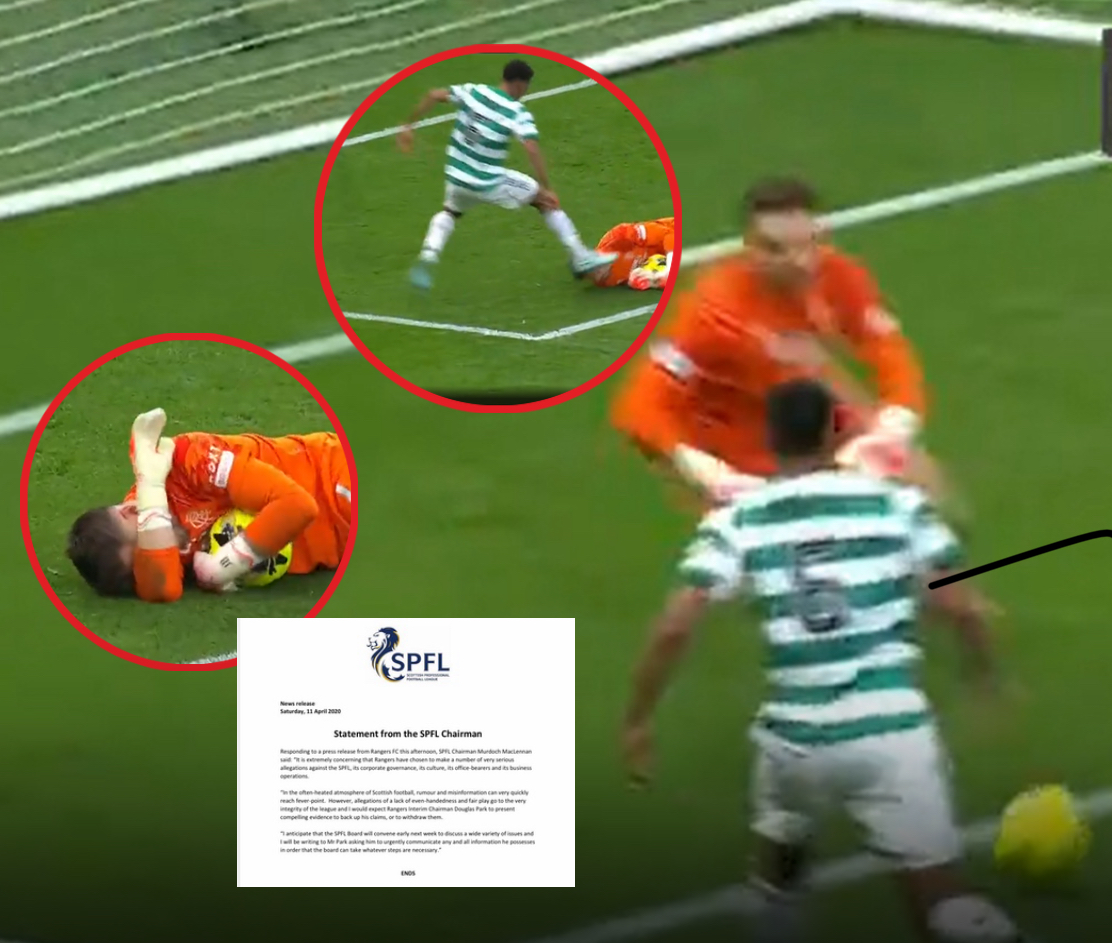The Scottish Professional Football League (SPFL) has released an official statement addressing the highly controversial incident involving Celtic defender Auston Trusty and the Rangers goalkeeper during the heated League Cup semi-final at Hampden Park.
The moment, which saw Trusty’s boot make contact with the goalkeeper’s head during a second-half scramble, has sparked widespread debate among fans, pundits, and former players. Many Rangers supporters argued that the challenge should have resulted in a straight red card, while others claimed that the contact was accidental and unintentional, part of the natural flow of play in a high-intensity match.
The SPFL’s decision — and its subsequent explanation — has left sections of the football community furious, reigniting discussions about VAR consistency, referee interpretation, and player safety in Scottish football.
The Incident: A Split-Second Collision that Ignited Debate
The flashpoint came midway through the second half, as Rangers pushed forward to equalize. A long ball was cleared by Celtic’s back line, leading to a quick counterattack. The Rangers goalkeeper, rushing off his line to intercept a through ball, collided with Auston Trusty, who was stretching to reach the ball first.
In real time, the contact appeared heavy — Trusty’s boot grazed the keeper’s head as both players went for the ball. The referee immediately blew for a foul, but after a brief check by the VAR team at Clydesdale House, no further action was taken.
The decision not to show a red card was met with instant outrage from the Rangers bench and their supporters in the stands. Replays circulated on social media within seconds, showing the point of contact between Trusty’s boot and the goalkeeper’s face. Hashtags like #RedCardAllDay and #SPFLBias trended across Scottish football circles on X (formerly Twitter) within minutes.
Referee’s View and VAR Decision
Match referee Andrew Dallas was seen consulting his earpiece for a VAR review, but after a short delay, he allowed play to continue without showing any card.
According to post-match reports, the VAR officials assessed the footage and deemed that while there was clear contact between Trusty’s boot and the goalkeeper’s head, the Celtic defender had no intent to endanger the opponent. The challenge was categorized as a “reckless action in the context of a legitimate attempt to play the ball.”
A senior SPFL referee analyst, speaking anonymously to the Scottish media, summarized the decision:
“The key factor here is intent and control. Trusty’s eyes were on the ball, and his leg movement was consistent with an attempt to play it. The unfortunate contact was a consequence of both players committing to the challenge simultaneously. That’s why the referee and VAR determined that it did not meet the criteria for serious foul play.”
However, that interpretation has done little to ease the frustration among Rangers fans, who view the incident as a pivotal moment that highlighted what they perceive as inconsistent officiating in matches involving the two Glasgow giants.
The SPFL’s Official Statement
In the aftermath of growing backlash online, the SPFL released a formal statement on its official website on Sunday morning. The governing body aimed to clarify the reasoning behind the non-red card decision, citing the established criteria under Law 12 of the IFAB Laws of the Game.
The statement read in part:
“Following a review of the incident involving Celtic’s Auston Trusty and the Rangers goalkeeper during the League Cup semi-final, the match officials acted in accordance with the Laws of the Game. The player’s challenge was deemed to be a legitimate attempt to play the ball with no excessive force or intent to endanger the safety of the opponent.
VAR confirmed that the on-field decision did not meet the threshold for serious foul play. While unfortunate contact occurred, it was considered incidental within the context of a footballing action.”
The SPFL also reaffirmed its confidence in the refereeing team, emphasizing that the Video Assistant Referee process was correctly followed and that all relevant camera angles were reviewed before the decision was finalized.
Fan and Media Reaction: “A Dangerous Precedent”
The statement did little to calm the storm. By Sunday afternoon, fan reactions had filled social media feeds, with both sets of supporters weighing in passionately.
Rangers fans accused the SPFL of “protecting” Celtic players, arguing that any similar challenge from their own team would have resulted in an immediate sending-off. Several fan pages and former players questioned how head contact — especially in an era of heightened awareness around concussion protocols — could be dismissed as accidental.
Former Rangers striker Kris Boyd, speaking on Sky Sports, said:
“I understand the referee’s perspective, but when you hit an opponent in the head with your boot, it’s hard to argue it’s not dangerous. Intent doesn’t always matter — it’s about endangering an opponent. In my view, it’s a red card under the current rules.”
Celtic fans, meanwhile, defended Trusty’s actions, pointing out that he was clearly going for the ball and that his momentum made the collision unavoidable. Many highlighted similar incidents in past matches where players escaped red cards due to accidental contact while competing fairly for possession.
Football analyst Michael Stewart offered a more balanced view:
“It’s one of those 50/50 calls where whichever decision the referee makes, half the country will disagree. The laws of the game allow some discretion for ‘natural footballing motion,’ and that’s what probably saved Trusty here.”
Player Safety Concerns and the Concussion Debate
The controversy has also reignited conversations about head injuries and the protection of goalkeepers. Modern football has become far more cautious about head contact and concussion risk, leading many to question whether VAR’s threshold for intervention remains too high.
Dr. John MacLaren, a Scottish sports medicine expert, commented:
“Whenever there’s a boot-to-head collision, even accidental, it’s concerning. The game has to continue evolving to prioritize player safety. Whether or not the referee was right by the law, it’s worth reviewing whether the laws themselves are sufficient to protect goalkeepers in such scenarios.”
The Rangers goalkeeper was seen receiving medical treatment after the incident but was able to continue playing, which may have influenced the officials’ judgment at the time.
Celtic’s Response and Trusty’s Reaction
Neither Celtic nor Auston Trusty released a formal statement after the match. Sources close to the club indicated that they considered the issue “settled on the field.” However, Trusty was reportedly surprised by the level of backlash, insisting privately that he had no intention to harm the opposing keeper and was simply attempting to make a play on the ball.
Celtic manager Brendan Rodgers addressed the matter briefly in his post-match interview:
“Auston went for the ball; it was a brave challenge by both players. There’s absolutely no malice in it. The referee handled it correctly, in my opinion.”
What the Rules Say: Understanding Law 12
Under IFAB’s Law 12, a red card is issued for “serious foul play” when a player “uses excessive force or endangers the safety of an opponent.” However, it also allows officials to consider intent, control, and context when judging such actions.
The challenge involving Trusty was ultimately deemed reckless but not violent, meaning it did not meet the “excessive force” threshold. In practice, this is the fine line referees walk every week — distinguishing between unfortunate accidents and punishable offenses.
Former FIFA referee Dermot Gallagher, speaking on a UK broadcast, summarized:
“If the boot was higher or if there was a clear swing motion, it’s a red card. But in this case, it’s more of a coming-together. VAR doesn’t intervene unless it’s clear and obvious, and that’s why the decision stands.”
Conclusion: Controversy That Will Linger
While the SPFL has officially closed the matter, the fallout from the Auston Trusty incident will likely persist for weeks. The decision has once again exposed the subjective nature of VAR and the challenges of officiating in emotionally charged derbies like Celtic vs Rangers.
For Rangers supporters, it’s another moment that fuels frustration with officiating consistency. For Celtic fans, it’s a reminder that intensity and aggression — when controlled — are part of what defines their team’s competitive spirit.
Either way, the incident has reignited one of Scottish football’s oldest debates: how far can passion and commitment go before they cross the line into recklessness?
As the dust settles, one thing is certain — the SPFL’s “no red card” decision may have been by the book, but it has left fans across Scotland still talking, still debating, and still divided.










